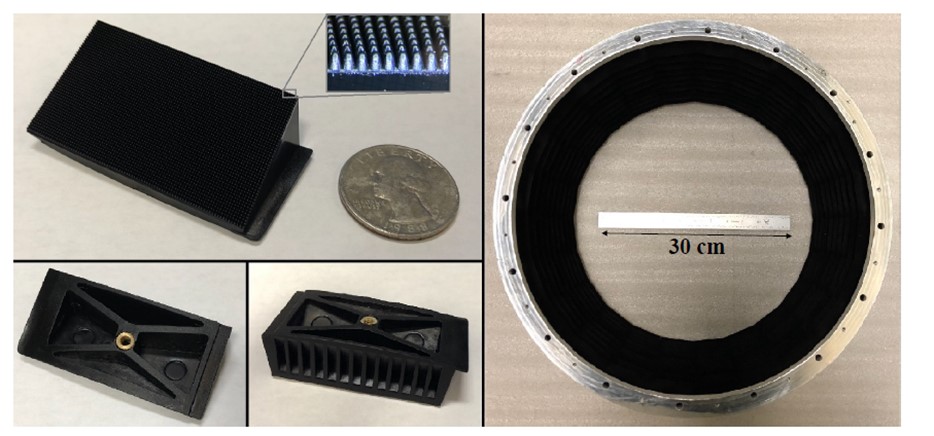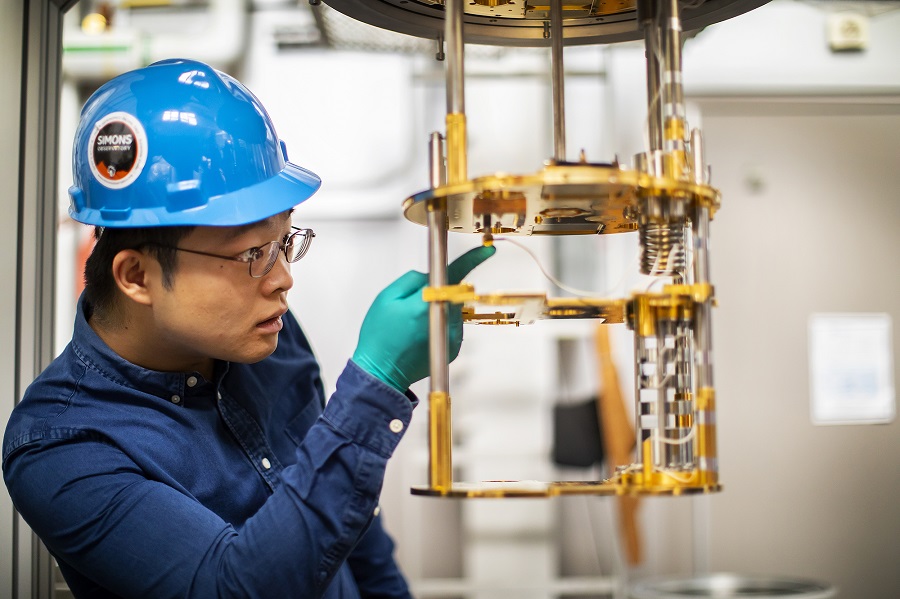About
26 January 2021
Metamaterial Tiles Boost Sensitivity of Large Telescopes
Low-cost, mass producible technology poised to help Simons Observatory yield new insights into how the universe began
WASHINGTON — A multi-institutional group of researchers has developed new metamaterial tiles that will help improve the sensitivity of telescopes being built at the preeminent Simons Observatory in Chile. The tiles have been incorporated into receivers that will be deployed at the observatory by 2022.
The Simons Observatory is the center of an ambitious effort to measure the cosmic microwave background — electromagnetic radiation left over from an early stage of the universe — using some of the world’s largest and most sophisticated ground-based telescopes. These measurements will help improve our understanding of how the universe began, what it is made of and how it evolved into what it is today.

Caption: Researchers developed new metamaterial tiles that will improve the sensitivity of telescopes at the Simons Observatory by absorbing stray light. The top left photo shows one tile, with its anti-reflective surface shown in the insert. The bottom left photos show the back of the tile, and the right photo shows the assembly of 240 tiles installed on the wall of an optics tube.
Credit: Zhilei Xu, University of Pennsylvania
“The Simons Observatory telescopes will use a new ultra-sensitive millimeter-wave camera to measure the afterglow of the big bang with unprecedented sensitivity,” said lead author Zhilei Xu from the University of Pennsylvania. “We developed a new low-cost absorbing tile that will be used in the camera to absorb environmental emissions that can obscure the signals we want to measure.”
In the Optical Society (OSA) journal Applied Optics, the researchers show that the metamaterial microwave tiles they developed absorb more than 99 percent of millimeter wave radiation and retain their absorptive properties at the extremely low temperatures in which the millimeter-wave camera operates.
“Because the tiles can be made by injection molding commercially available materials, they are an economic, mass-producible and easy-to-install solution to what has been a long-standing problem,” said Xu. “With this technology, the Simons Observatory will transform our understanding of the universe from many aspects, including the beginning of the universe, the formation and evolution of the galaxies and the ignition of the first stars.”
Working at low temperatures
Ground-based millimeter-wave telescopes use receivers that are cooled to cryogenic temperatures to reduce noise and thus boost sensitivity. Receiver technology has advanced to the point where any amount of stray light can degrade the image while also decreasing the sensitivity of the detector. A better way to suppress stray light within the receivers would further increase their sensitivity to the very faint signals coming from deep within space.

Caption: Thermal testing of the new metamaterial tiles in an advanced cryogenic facility showed that they could be effectively cooled to the cryogenic temperatures necessary.
Credit: Eric Sucar, Penn Today
However, developing a material that can suppress stray light while operating at such extremely low temperatures is quite challenging. Previous attempts resulted in materials that either couldn’t be cooled effectively to cryogenic temperatures or didn’t achieve the necessary combination of low reflectance and high absorption. Other solutions have also tended to be difficult to install or challenging to mass produce.
To overcome these challenges, the researchers turned to metamaterials because they can be engineered to achieve specific properties that don’t occur in nature. After complex electromagnetic simulation studies, the researchers designed metamaterials based on a material that combined carbon particles and plastic.
Reducing reflection
Although the plastic composite exhibited high absorption in the desired microwave region of the electromagnetic spectrum, the surface reflected a significant amount of radiation before it could get inside the material to be absorbed. To reduce the reflection, the researchers added an anti-reflective coating that was tailored using injection molding.
“The low-reflectance surface combined with high-absorption bulk material allowed the metamaterial absorber tiles to deliver excellent suppression of unwanted signals at cryogenic temperatures close to absolute zero,” said Xu.
After ensuring that tiles made of the new metamaterial could mechanically survive thermal cycles from room temperatures to cryogenic temperatures, the researchers verified that they could be effectively cooled to -272° C (-458° F) and then measured their optical performance. “We developed a custom test facility to measure the performance of the tiles with high fidelity,” said Grace Chesmore, a graduate student at the University of Chicago who led the optical measurements of this research. The testing showed that the metamaterial exhibited excellent reflectance properties with low scattering and that it absorbed almost all of the incoming photons.
Caption: Zhilei Xu installs 240 of the new absorptive tiles into an optics tube that will be used in the Simons Observatory Large Aperture Telescope Receiver.
Credit: Zhilei Xu, University of Pennsylvania
“As detector sensitivity continues to improve for millimeter-wave telescopes, it becomes crucial to control scattered photons,” said Xu. “The successful combination of a metamaterial and injection molding manufacturing opens up many possibilities for millimeter-wave instrument scientific instrument design.”
The work was a result of a large global collaboration that included researchers from the University of Pennsylvania, the University of Chicago, Goddard Space Flight Center, Massachusetts Institute of Technology and other institutions.
Paper: Z. Xu, G. E. Chesmore, S. Adachi, A. M. Ali, A. Bazarko, G. Coppi, M. Devlin, T. Devlin, S. R. Dicker, P. A. Gallardo, J. E. Golec, J. E. Gudmundsson, K. Harrington, M. Hattori, A. Kofman, K. Kiuchi, A. Kusaka, M. Limon, F. Matsuda, J. McMahon, F. Nati, M. D. Niemack, A. Suzuki, G. P. Teply, R. J. Thornton, E. J. Wollack, M. Zannoni, N. Zhu, “The Simons Observatory: Metamaterial Microwave Absorber (MMA) and its Cryogenic Applications,” Applied Optics, 60, 4, 864-874 (2021).
DOI: https://doi.org/10.1364/AO.411711
About Optica Publishing Group
Optica Publishing Group is a division of the society, Optica, Advancing Optics and Photonics Worldwide. It publishes the largest collection of peer-reviewed and most-cited content in optics and photonics, including 18 prestigious journals, the society’s flagship member magazine, and papers and videos from more than 835 conferences. With over 400,000 journal articles, conference papers and videos to search, discover and access, our publications portfolio represents the full range of research in the field from around the globe.
About Optical Materials Express
Optical Materials Express is an open-access journal focusing on the synthesis, processing and characterization of materials for applications in optics and photonics. It is published by Optica Publishing Group and emphasizes advances in novel optical materials, their properties, modeling, synthesis and fabrication techniques; how such materials contribute to novel optical behavior; and how they enable new or improved optical devices. The Editor-in-Chief is Andrea Alù from City University of New York, USA. For more information, visit Optical Materials Express.
About Applied Optics
Applied Optics publishes in-depth peer-reviewed content about applications-centered research in optics. These articles cover research in optical technology, photonics, lasers, information processing, sensing and environmental optics. Applied Optics is published three times per month by The Optical Society and overseen by Editor-in-Chief Gisele Bennett, MEPSS LLC and Georgia Institute of Technology, USA. For more information, visit OSA Publishing.
About The Optical Society
Founded in 1916, The Optical Society (OSA) is the leading professional organization for scientists, engineers, students and business leaders who fuel discoveries, shape real-life applications and accelerate achievements in the science of light. Through world-renowned publications, meetings and membership initiatives, OSA provides quality research, inspired interactions and dedicated resources for its extensive global network of optics and photonics experts. For more information, visit osa.org
Media Contact
